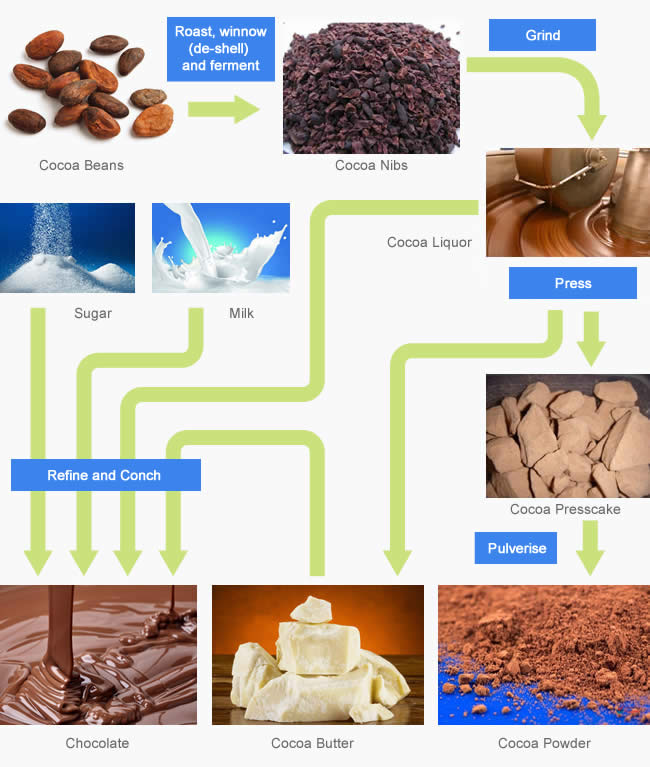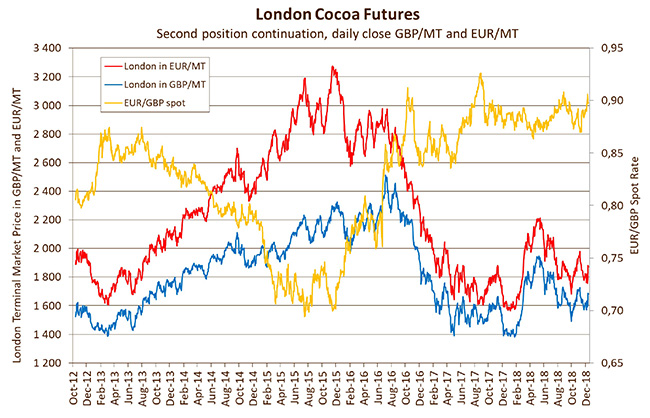Understanding Chocolate Pricing
Posted: 22 Jan 2019
Edited May 2024: For an updated article on chocolate and cocoa pricing, read our guides Living with Higher Cocoa Prices and Costs & Pricing: a Beginners' Guide.

The Cocoa Bean is the basic raw material of the chocolate-making process which is traded on commodities exchanges in London (LIFFE) and New York (ICE). Cocoa Liquor is derived directly from the beans, so its price is directly linked to the price of the beans. Cocoa Powder and Cocoa Butter are both products of the pressing process of the cocoa liquor. They are traded independently and their prices are usually quoted as a ratio of the cocoa bean price.

Cocoa butter is mostly used to make chocolate but is also increasingly used in pharmaceuticals and cosmetics. Cocoa powder is mostly used in cookies, cakes, ice cream and drinks. Consequently the demand and therefore price of cocoa butter, can fluctuate independently of the price of cocoa powder. Normally when the cocoa butter ratio goes up, the cocoa powder ratio goes down and vice versa. So even if the price of beans remains unchanged, the price of cocoa butter can go up or down; this is relevant because the recipe for most chocolate products will require the addition of at least some extra cocoa butter to the cocoa liquor.
For example, assume a processor has a demand for 1000kgs of cocoa butter. So they press 2000kgs of cocoa liquor to produce the 1000kgs of butter (liquor yields approx. 50% butter and 50% cocoa solids), which also yields 1000kgs of cocoa powder. But now suppose that they only have a demand for 800kgs of powder. This means they have too much powder and this excess supply drives down the price of the cocoa powder until the demand equals the supply.
As a result, if demand for cocoa butter gets pushed up faster than the demand for cocoa powder, perhaps due to growing demand from another sector such as cosmetics, then the butter price goes up and the powder price comes down.
So in summary, movements in chocolate prices can be quite complex as they depend on the interaction of a number of different factors, including currency exchange rates and the amount of extra cocoa butter added in the recipe. The table below illustrates these interactions, but please note that actual price changes will of course depend on the relative sizes of the changes in costs as well as the recipe of the chocolates.
| Dark Chocolate | Milk Chocolate | White Chocolate | |
|---|---|---|---|
| Price of cocoa beans or sugar UP (and everything else unchanged) |
 |
 |
 |
| Milk price UP (and everything else unchanged) |
 |
 |
 |
| Cocoa butter ratio UP, cocoa powder ratio DOWN (and everything else unchanged) |
 |
 |
 |
| Cocoa butter ratio DOWN, cocoa powder ratio UP (and everything else unchanged) |
 |
 |
 |
Glossary
Cocoa liquor ratio = cocoa liquor price / cocoa bean price
Cocoa powder ratio = cocoa powder price / cocoa bean price
Cocoa butter ratio = cocoa butter price / cocoa bean price
Combined cocoa butter ratio = cocoa butter ratio + cocoa powder ratio
.svg)
.png)